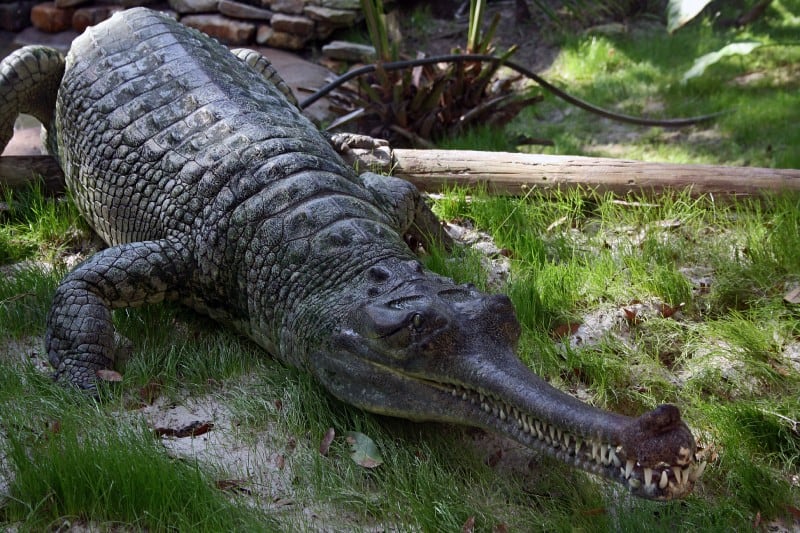
Gharial Facts
- The relatively simple term of Gharial serves as the most often used common name for an impressive variety of crocodilian. This amazing reptile also goes by other alternate names, though, including such terms as the gavial and the fish-eating crocodile.
- The scientific name for it, meanwhile, remains the somewhat tongue-twisting term of Gavialis gangeticus. Regardless of which name one uses to refer to it, however, the remarkable animal represents a highly fascinating species of powerful reptile.
- This creature received its first scientific name as a result of the work of the renowned German naturalist, Johann Friedrich Gmelin, in 1789. That name was later changed, though, at the proposal of another German naturalist, Nicolaus Michael Oppel.
- Though once quite plentiful throughout the entirety of its natural range, its population began declining sharply in the 1930’s. That number has now shrunk to such an extent that the IUCN currently lists it as Critically Endangered on its Red List.
- Its estimated population recently numbered only 235 individuals, putting the magnificent Gharial in a precarious situation. Although efforts to bolster that continue, it faces numerous threats, such as the ongoing effects of climate change.
Related Articles
Gharial Physical Description
Despite being less well-known than some of its relatives, the fascinating Gharial nonetheless remains a physically impressive species. In fact, this particular reptile represents one of the largest of all known crocodilians, at least in terms of body length.
Like many reptiles, though, this marvel of Nature also displays a moderate degree of the physiological trait of sexual dimorphism. In the instance of this specific animal, that distinctive evolutionary trait manifests itself in terms of sheer physical size.
As a result, the male of the species attains a greater average length than the female. His overall length averages around 20 ft (6 m), while hers averages roughly 14.75 ft (4.5 m). Males also typically weigh slightly more, at about 400 lb (181 kg), against her 350 lb (159 kg).
Typically, the adult Gharial possesses a dark olive color tone, while young ones present a pale olive with dark brown spots or cross-bands. Its stomach, meanwhile, displays a yellowish-white. The back also darkens with age, turning nearly black after around 20 years.
Its most easily and frequently noted divergence from its relatives, however, remains the shape of its snout. This develops as quite elongated, and very thin in relation to the rest of the body. It further has a bulbous structure on the end of the snout, that it uses to hiss with.
- Kingdom: Animalia
- Phylum: Chordata
- Class: Reptilia
- Order: Crocodilia
- Family: Gavialidae
- Genus: Gavialis
- Species: G. gangeticus
Gharial Distribution, Habitat, and Ecology
Although the awesome Gharial once inhabited a significant portion of its part of the world, it now only appears in an estimated 2% of that previous range. This magnificent product of evolution evolved as endemic to the majority of the subcontinent of India, in Asia.
The powerful, but relatively timid reptile also once thrived in all the major river systems of the Indian Subcontinent. Its territory once spanned the rivers of its part from the Indus River in Pakistan across the Gangetic floodplain to the Irrawaddy River in Myanmar.
The gorgeous reptile evolved as perhaps the most highly aquatic of all its relatives. Due to that, its choice of habitat remains dictated by its needs, placing it always either in or near bodies of water. This consists almost exclusively of various rivers in its area.
Individuals spend almost all their time in the water, usually only leaving it to bask themselves in the sun. This activity most commonly takes place in small groups, with a dominant adult male, several females, and multiple young of both genders per group.
Like all its relatives, the Gharial feeds entirely as an active predatory carnivore. The young generally feed on small fish, tadpoles, frogs, and even insects. Adults, however, generally consume fish, which it swallows whole, but occasionally feed on crustaceans.
Species Sharing Its Range
Check out our other articles on 5 Astonishing True Bugs, Black-and-white hawk-eagle, Christmas Island, Purple Pitcher Plant, Sangai, European Mantis, Basking Shark, Hellbender Salamander
